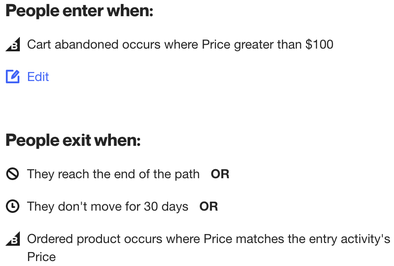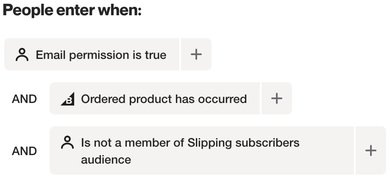Working with filters
Overview
Filtering people enables you to view and use segments of people based on selected categories, fields, and conditions.
When you create a filter on the People page, you can:
- View a segment of people.
You can also filter people when creating an email or SMS campaign to send your campaign to a one off audience that you don’t intend to re-use.
Learn more about using filters for campaigns.
In journeys and playbooks, you’ll use a filter to specify the conditions and criteria by which people start the journey or enter the playbook.
Using a filter versus creating an audience
Using filter results for an email or SMS campaign is recommended one-off campaigns where you don’t intend to re-use the segment as an audience. Sending a campaign using a filter rather than creating a new audience will help prevent the build up of unnecessary assets over time.
Audiences are designed to represent key customer lifecycle stages (such as subscribers) and will provide you with visibility into the growth and engagement of this audience over time. You should only create an audience when you intend to:
- Grow or contract the audience e.g. Customers (grow), Slipping Customers(contract).
- Use the audience as a subscription preference.
- Track a specific group of people over time.
- Use the same audience in campaigns over and over.
Learn more about audiences in Working with audiences.
Filter categories and fields
The fields within each filter category are described on the following pages:
- System filter fields:
- Accounts (previously organizations (if enabled)
NOTE: Filters on Account fields will only return results for accounts that have one or more associated (linked) contacts.
- Salesforce person fields and activities and attributes
- Calendly person fields and activities and attributes.
NOTE: If you have integrated a data source (such as Shopify), activity fields and a category containing people fields associated with the integration will appear in the filter list.
Filter conditions
The filter conditions available depends on the category (and fields within that category) you choose, which could be based on audience, person, organization (if enabled), a data source integration, or a specific activity a person has been involved with.
Learn more about filter conditions.
Create a filter
The following steps are to create a filter from the People page, but you can follow a similar procedure anywhere you see Filter or Add filter (such as in the email or journey campaign wizard).
- On the People page, click Filter.
- Choose filter conditions from any of the following categories:
- Audience
- Person
- Accounts (previously organizations) if enabled)
- If you have integrated a data source (such as Help Scout), activity fields and a category containing filter conditions associated with the integration will appear in the filter list.
- When you have selected your condition/s, click Done to see the results.
You can create filters using a number of different operators, grouping and nesting methods, depending on the results you want.
For example, the filter query Clicked email has occurred where email name is Thanks for subscribing and device is mobile will return results for one activity. If these are the results you want, you can create a filter using nested conditions.

However, the filter query Clicked email has occurred where email name is Thanks for subscribing and Clicked email has occurred where device is mobile may return results for two separate activities, or the same one. If these are the results you want, you can create a filter using separate conditions.

Creating a condition group enables you to query multiple conditions together. You can also change the condition operators from AND to OR to modify your filter results.
Note: When filtering an activity's attribute, suggested values will pre-populate based on data from the last 12 days.
Create a filter using nested conditions
Creating a filter of nested conditions ensures that you are capturing criteria related to one activity, rather than multiple activities.
The nested activity conditions begin with:
- Has or has not occurred,
- First occurred,
- Last occurred,
- Frequency & time, or
- Occurs.
NOTE:
- Occurs is only available in playbooks and journeys as it captures future activities (as opposed to Has or has not occurred which captures activities from the past).
- For connected data sources, when you perform a backfill of activities, any activities that are older than 6 hours will not quality for "occurs" conditions.
To create a nested condition:
- Click Filter.
- Click Filter by activity then choose the activity you wish to filter by.
- Choose a nested condition, then:
- Use When to specify:
- how many times an activity occurred, or
- how many days ago an activity occurred.
NOTE:
- For filter conditions that return results from a specified last number of days, or a When type condition (in the last, more than, exactly), the time calculated is day-based, not hour-based. For example, in the last 1 day means from 12:00 AM this morning until 11.59 PM tonight, not from 24 hours ago until now.
- Occurs does not contain a When clause as it can only capture future activities.
- Use Where to specify an activity attribute (such as campaign type) and the value you want results to match.
NOTE:
- If you select has occurred or has not occurred and do not specify a Where clause, the filter will return matches for all time.
- If you select has occurred or has not occurred and you do specify a Where clause, the filter will return matches from within the last 90 days only (unless you use data retention).
- Use Match with entry activity attribute to specify an exit activity attribute to match the entry activity attribute (such as a Salesforce opportunity ID).
NOTE:
- Match with entry activity attribute is only available in journeys, under Occurs.
- The occurs activity is stored for the length of time that the contact is in the journey (available for more than the default 90-day limit, even if data retention is not enabled for the activity).
Learn more about matching activity attributes in journeys.
- Click the trash icon to remove a When or Where clause.
- Click Done to view the results.
EX:
Using nested conditions can help you find:
- VIP customers based on their total spend and number of orders placed.

- People who booked a flight to a specific location for a specific date.

- People who donated a particular amount in the last 30 days.

- Salesforce opportunities created for a specific stage in your sales pipeline.

- People who abandoned a cart before checkout to encourage them to make a purchase.

Create a filter using separate conditions
Adding more than one condition to your filter will enable you to find results that match multiple, discrete activities.
Add separate filter conditions by clicking Add condition. Click Clear to clear all conditions and start again.
EX:
Using separate or single conditions can help you find:
- People who have been subscribed for a while and have not yet made a purchase.

- People who are marketable newsletter subscribers.

- Customers who made multiple purchases from your store.

Create a condition group
Creating a condition group enables you to return results for multiple conditions together.
To create a condition group:
- Click Filter.
- Select a condition.
- Click the add icon next to the condition and select another condition.
- Start a new condition group by clicking Add condition and repeat the preceding step.
EX:
Using condition groups can help you find:
- People who are subscribers and have not yet made a purchase, or people who have opened a new subscriber email and not yet made a purchase.

- Customers who purchased a product in the last 60 days and live near Sydney.

- People who submitted a form on your website but did not complete your website sign-up.

Use AND/OR operators
The default operator between filter conditions is AND. You can broaden your filter matches by changing AND to OR by clicking on AND between the conditions (and change back to AND by clicking OR).
Learn more about using AND/OR operators.
Account (previously organizations) filters
When using a filter from the Accounts page, filter conditions will return accounts that match the criteria defined.
NOTE: Filters that include contact fields will only be able to return accounts that have contacts present to meet those conditions.
Filter errors
When creating a filter, if you see a red condition, it means that the condition requires a value or the operator/s you have chosen are not valid. If a condition is red, it has not yet filtered your results.
Learn more about filter errors.
